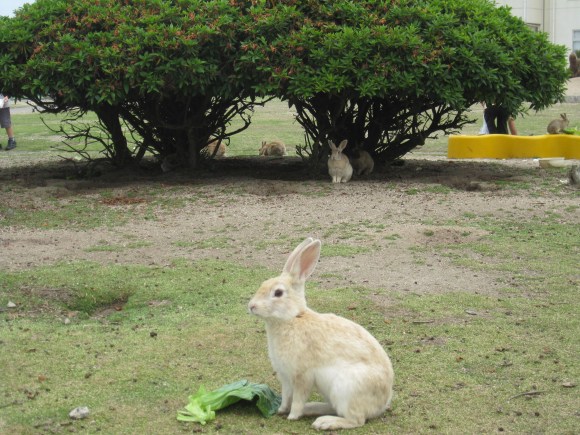
In some ways, the island of Okunoshima, in western Japan’s Setonaikai Inland Sea, seems like a terrible vacation spot. It’s already in an out-of-the-way region of the country, and with no connecting bridges, the only way to get there is by boat.
Then there’s its dark past. During the 1920s, ‘30s, and early ‘40s, Okunoshima was the site of a secret chemical weapons lab for the Japanese Imperial Army. The clandestine work being carried out there earned it the sinister nicknames Poison Gas Island and The Island Erased from the Maps.
Happily, the postwar years have seen a return to more peaceful, benign activities on Okunoshima. As a matter of fact, in the last few years it’s become one of the area’s most beloved tourist destinations, and the reason why is easy to see from the other name Okunoshima is called by, Rabbit Island.
In contrast to the numerous cat islands that dot Japan’s waters, Okunoshima, with a coastal length of 4.3 kilometers (2.7 miles), is home to some 700 wild rabbits.
Ferries from two ports connect the island to the rest of the country. For travelers coming from Kyushu or one of the cities on the main island of Honshu, such as Tokyo or Kyoto, the most convenient route is to travel by the Shinkansen bullet train to Mihara Station in Hiroshima Prefecture. From there, it’s about a 20-minute ride south on the Kure Line to Tadanoumi Station, which is within walking distance of the port where ships depart for the 13-minute cruise to Okunoshima.
Alternatively, you can do what we did and take the ferry from Sakari Port on Omishima Island in Ehime Prefecture. Since Omishima is part of the beautiful Shimanami Kaido Cycling Road, this is a great option for those getting around the region by bike, as getting to Sakari involves only about a 20-minute detour from the regular course. Ferries from here also reach Okunojima in under 15 minutes.
▼ The Shimanami Kaido
It goes without saying that you should only make the trip to Okunoshima if you’ve got a thing for rabbits. Depending on the timing of your visit, being OK around large groups of kids would also be a plus. We stopped by on a Sunday morning and shared the ferry and island with several families, tykes in tow, who’d come to see the island’s bunnies.
No sooner had we set foot on the island than we came across a contingent of Okunoshima’s long-eared residents.
We’d caught the first ferry from Sakari, which departs at 9 a.m., and the animals were up and ready for breakfast when we arrived. Many of the people who’d come over on the boat with us carried bags of cabbage, chopped carrots, or other vegetables to give to the rabbits.
Still, these are wild animals, and there are a couple of ground rules and safety precautions visitors are asked to observe. Signs caution against feeding the rabbits out of the palm of your hand. They’re likely to nick you with their sharp teeth, opening up a wound and the risk of infection at the same time.
As cuddly as they may look, visitors are also asked to refrain from picking the animals up. Chasing after them is also against the rules, and to be honest we can’t see why you’d even be tempted to. They’ve become incredibly comfortable around people, and won’t scamper away no matter how close you get.
▼ Hey guys.
▼ “Oh, hey, welcome to our island.”
While some rumors speculate the descendants of test subjects from the poison gas lab, former workers say that all such animals were disposed of when the facility was shut down by the Allied Forces at the end of World War II. Instead, it seems that the current rabbit population traces its roots to the early 1970s, when a group of eight rabbits that had been raised at the elementary school on a different island were set loose on Okunoshima.
If eight healthy human beings were trapped together on an island, we imagine it wouldn’t be long before some of them stopped spending the night alone. The same goes for rabbits, and with their well-known diligence in carrying out their biological duty to keep the species going by creating the largest next generation possible, Rabbit Island turned into what it is today.
If you’d like to be in close proximity to rabbits 24 hours a day, you can even spend the night on Okunoshima, which has both a seaside campground and a hotel. The animals aren’t allowed inside the latter though, and a low fence keeps them out of the area where campers pitch their tents.
While we were never more than a few seconds away from our next rabbit spotting, the greatest concentration of them is on the grassy fields near the hotel. There’s a shuttle bus that runs between there and the port, but should you miss it, it’s only about a 10-minute walk, which includes some nice views of the Inland Sea.
Along the way, you’ll pass by the visitor center, where inside you can learn more about the island’s ecosystem.
▼ And where outside you’ll find these rabbit ear simulator/sculptures
Japanese manners stipulate that it’s good form to bring a gift when visiting the home of another. If you made the cultural faux pas of showing up on Okunoshima without anything for the bunnies, the hotel sells cups of rabbit feed for 100 yen (US $1), or small bags for 540 ($5.27). We doubt you’d have any trouble going through a whole sack, since we saw dozens of animals frolicking and enjoying the food being provided by their numerous doting visitors.
▼ Remember: The water in this tank is for rabbits, not people.
▼ This seems as good a time as any to point out that Japanese carrots are amazingly delicious.
Being surrounded by so many bunnies, you might think they all start to blend together, especially since they all seem to be the same breed. Even still, many of them find little ways to stand out, sometimes by literally standing.
Then there’s this little guy, who pulls off the trick of somehow being even cuter than his already adorable brethren.
Cute as they may be, there is one danger to watch out for. As you might have noticed in some of these pictures, the rabbits on Okunoshima like to dig little bunny-sized pits to rest in.
While they sure do look cozy in there, they obviously don’t go to the trouble of filling the compact trenches back in with soil every time they crawl out. The result is that during the midmorning, when the animals are actively moving about and searching for food, the ground of Okunoshima is littered with holes.
You’ll want to keep an eye out for them when you move off of the paved road, since one misstep is a good way to twist an ankle or tweak a knee, something cyclists travelling the Shimanami Kaido will especially want to avoid.
▼ Don’t expect the rabbits to let you ride them back home if you injure yourself, either.
That minor concern aside, though, we wholeheartedly recommend spending a couple hours on Omishima. Really, the only downside is how badly we want to go back.
In the meantime, we may have to tide ourselves over with an afternoon at Tokyo’s rabbit cafe.
Related: Kyukamura Okunoshima website (English), Okunoshima ferry schedule (Japanese)
Photos: RocketNews24

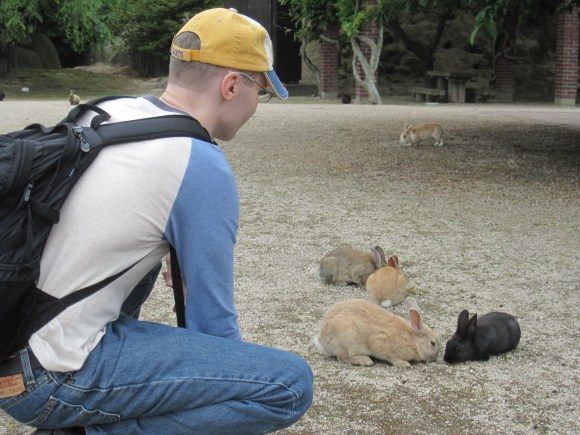
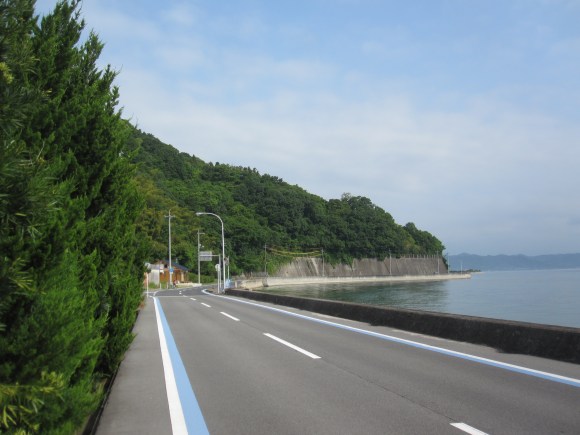
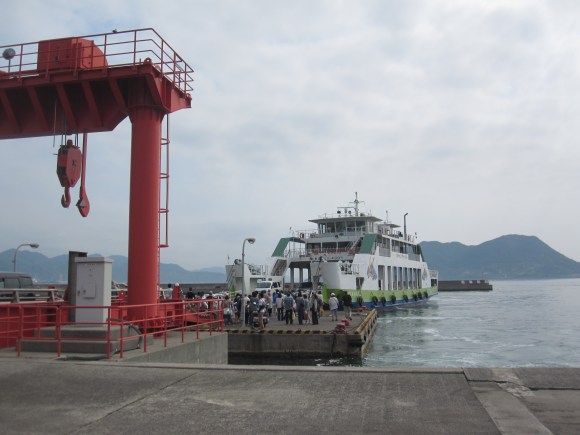
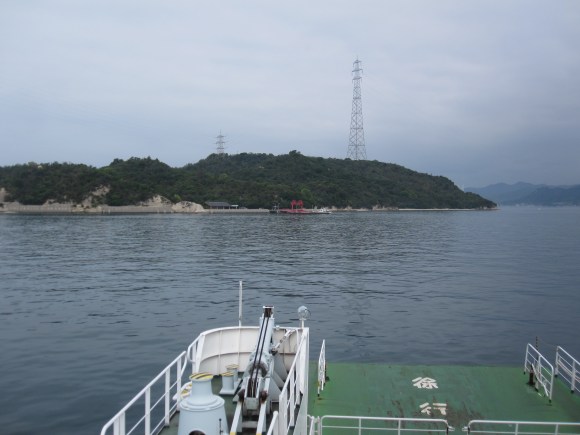

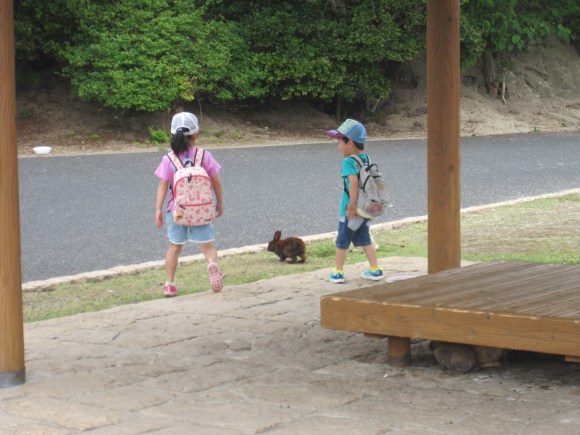
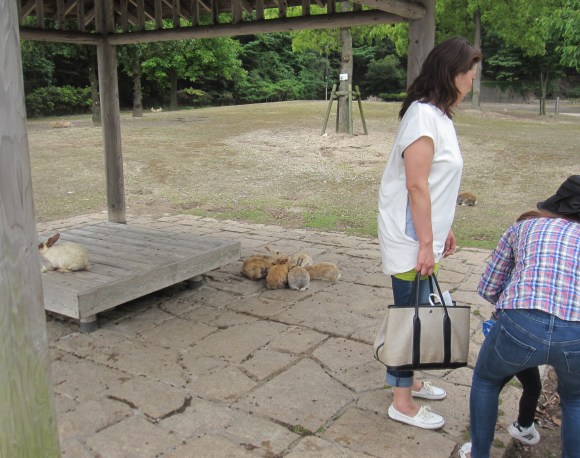
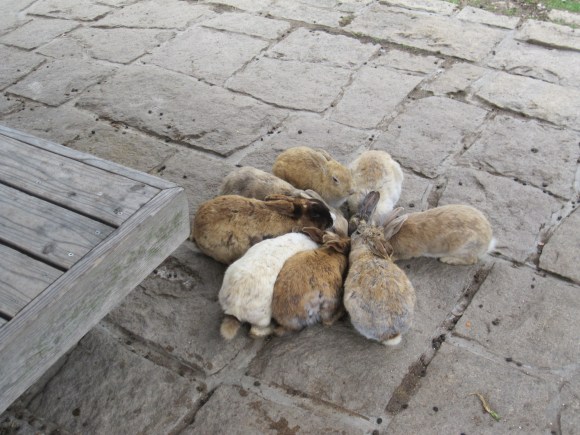
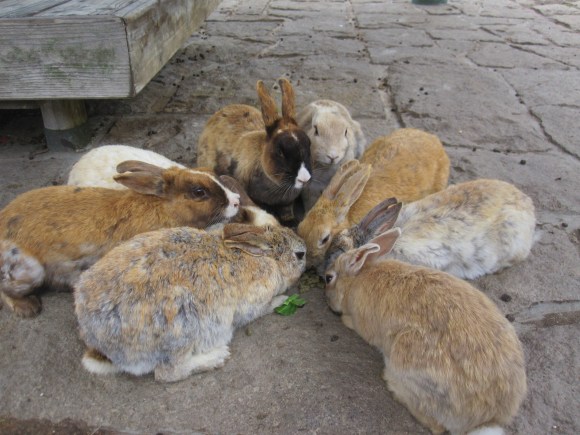
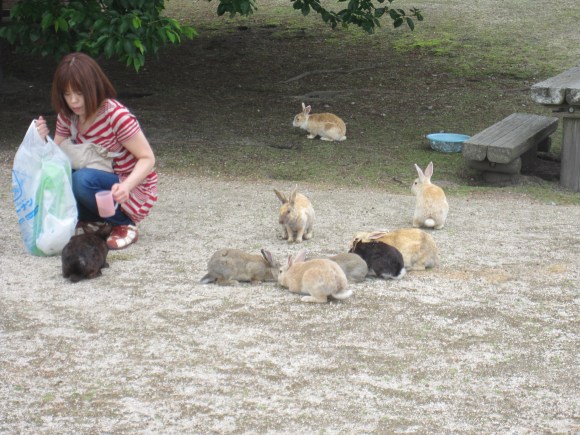
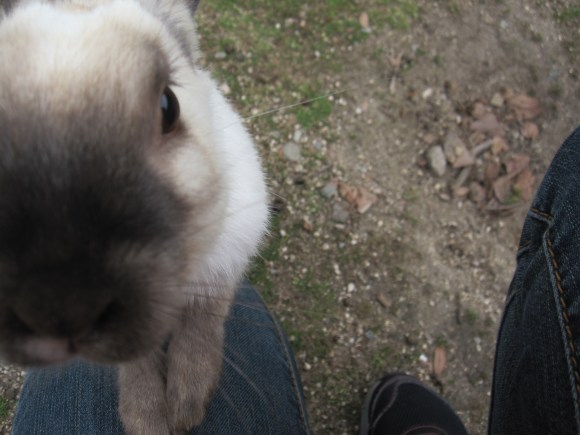
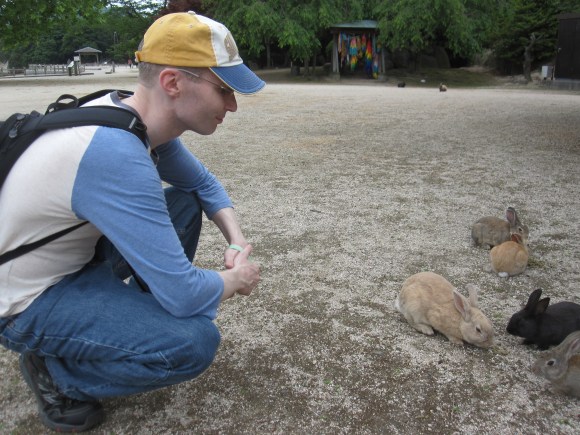
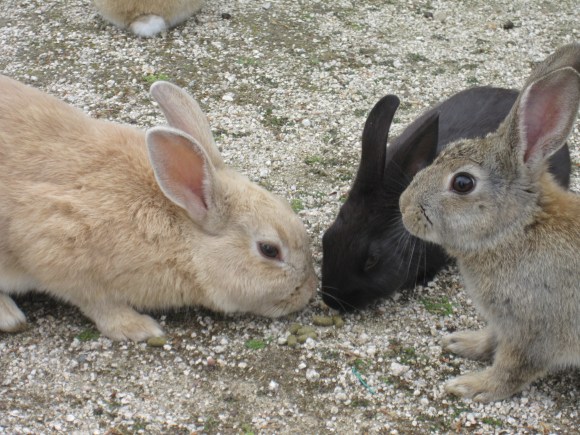
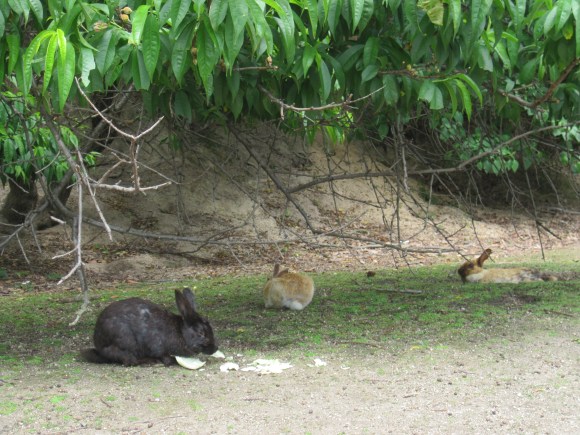
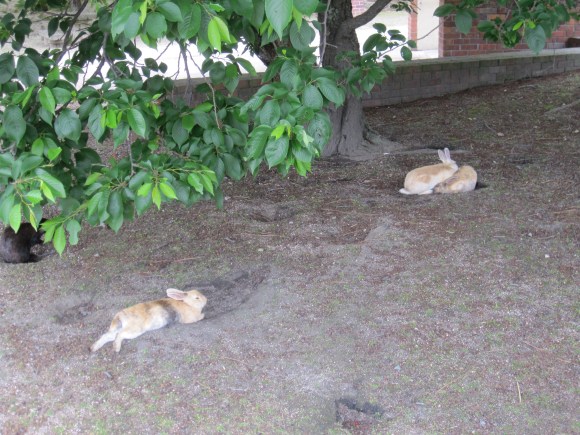
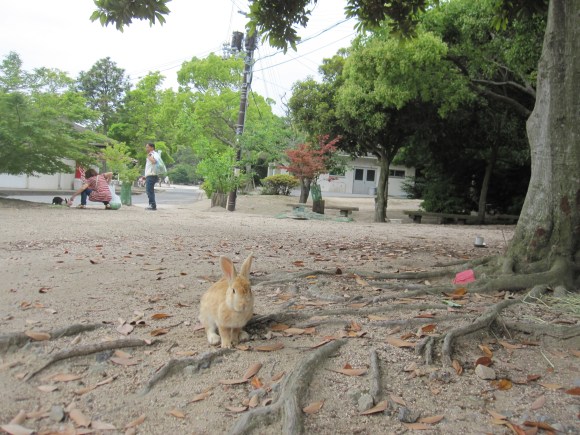
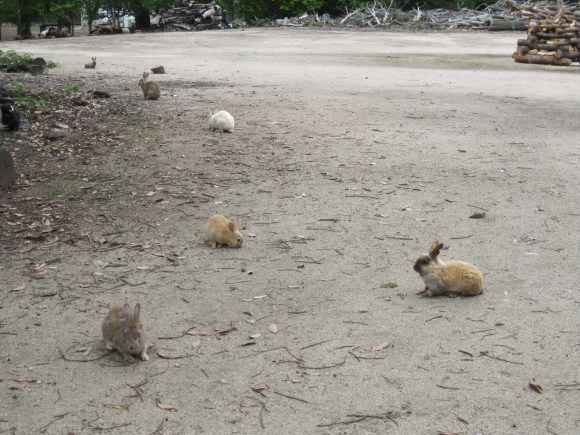
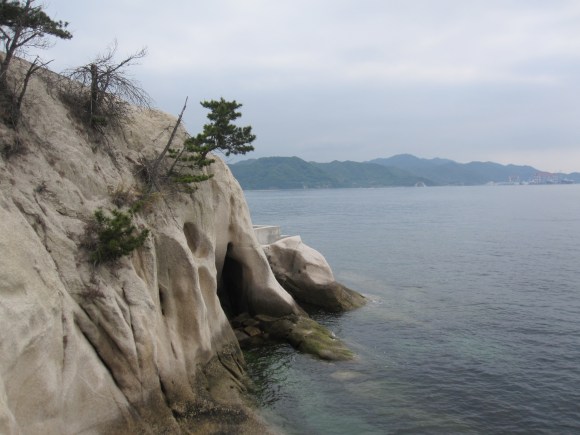

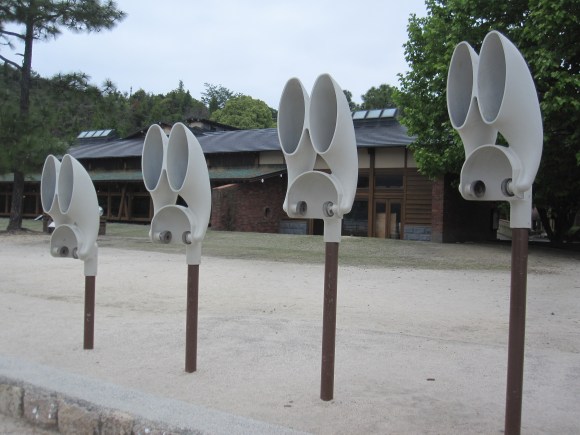
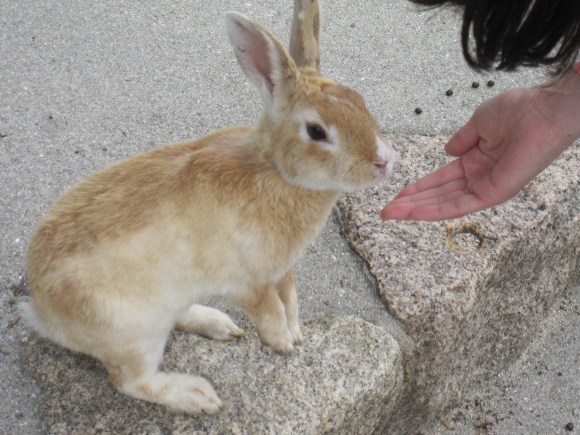
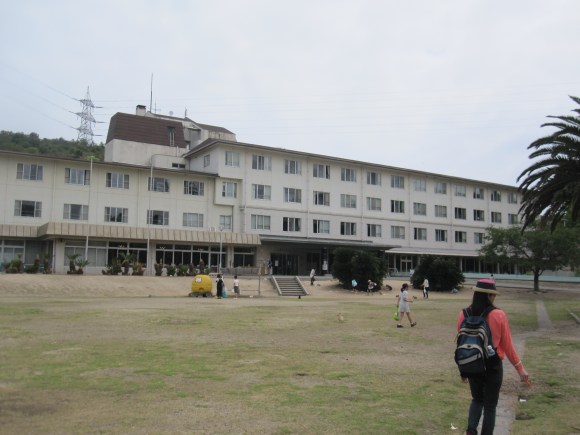
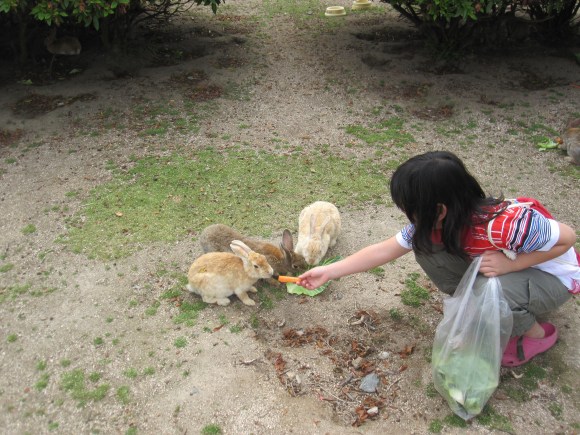
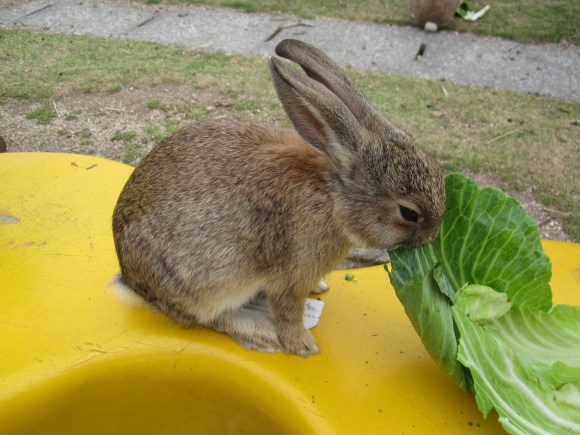
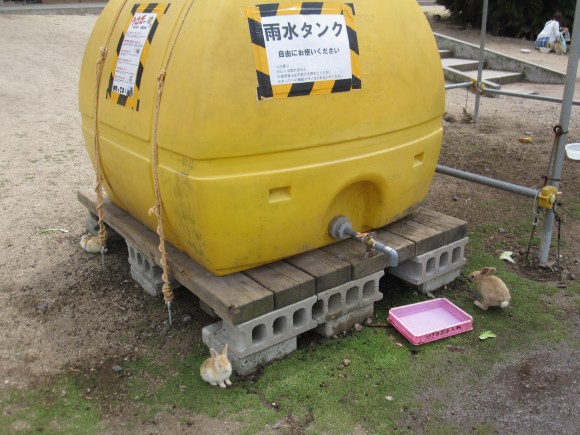
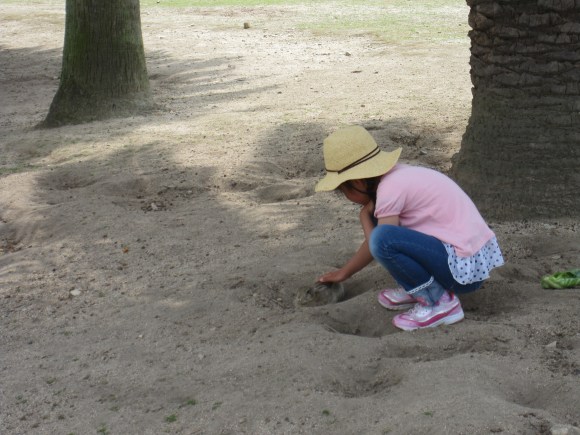
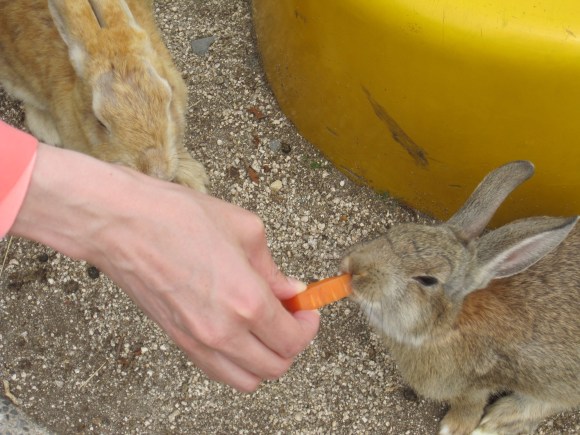
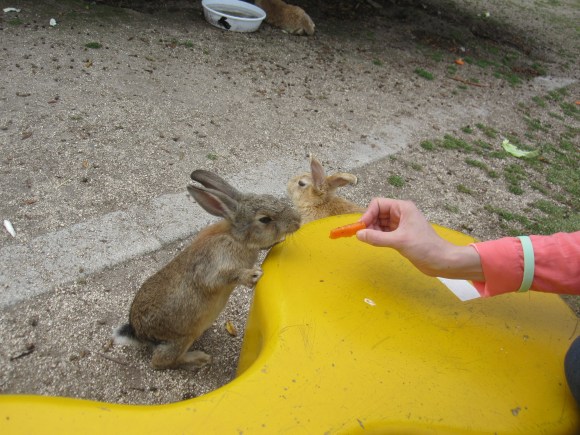
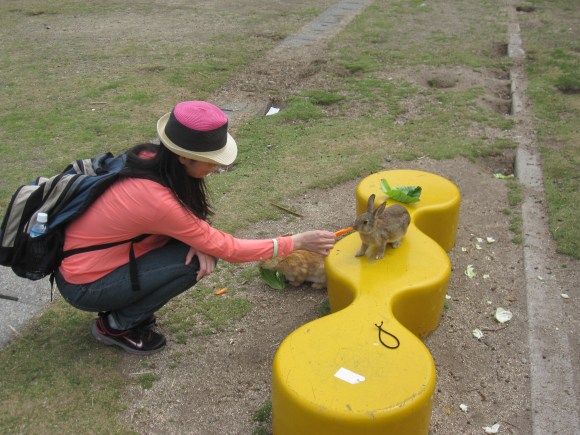
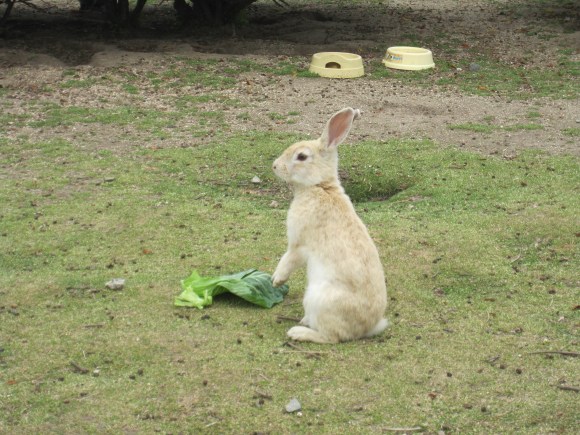
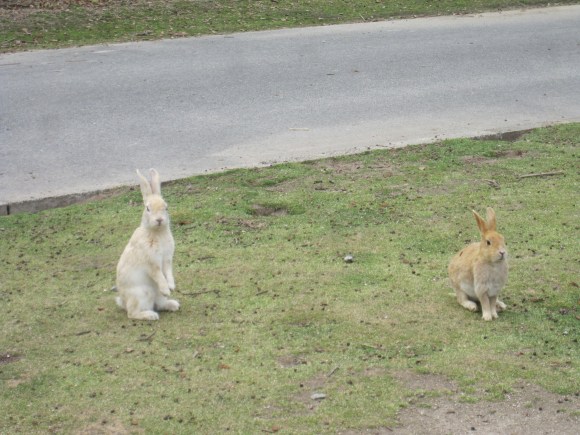

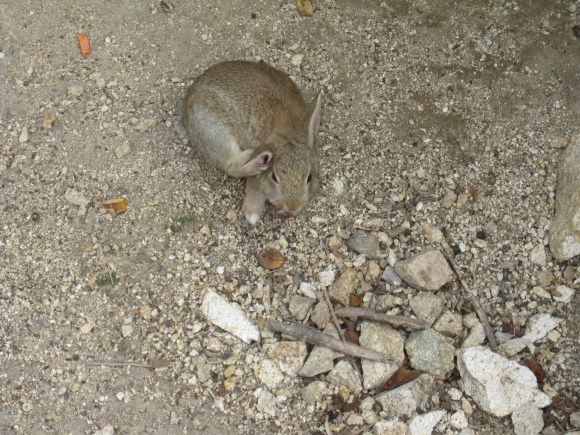
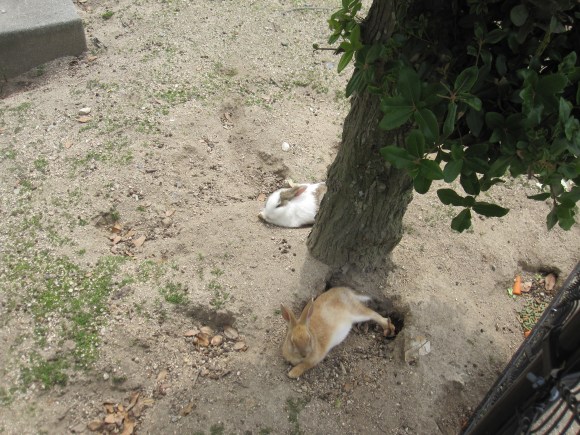
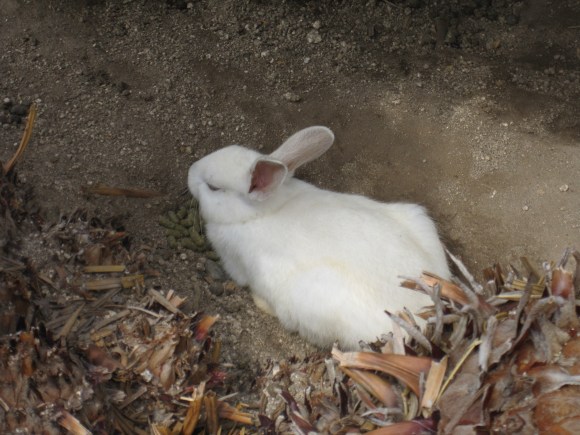
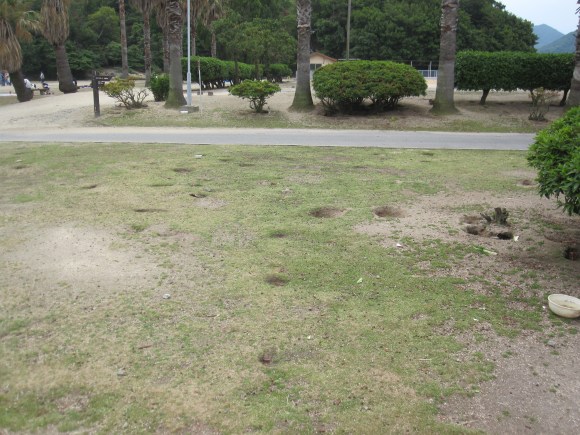
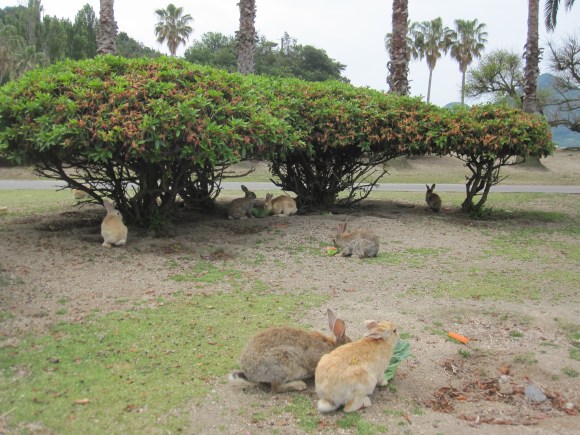
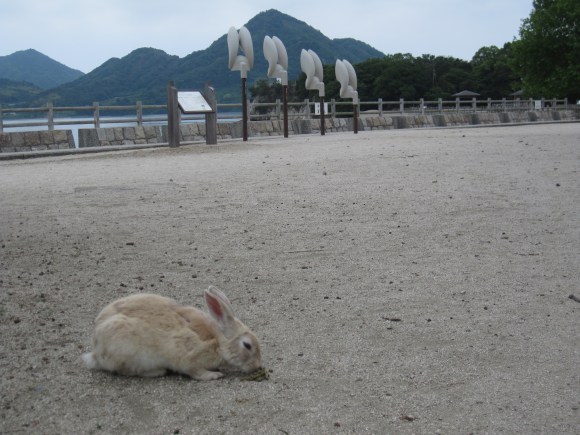
 We visited Rabbit Island in a bunny suit covered in food, to become a rabbit ourselves【Photos】
We visited Rabbit Island in a bunny suit covered in food, to become a rabbit ourselves【Photos】 This Year of the Rabbit, visit some of the best Japanese sightseeing spots related to rabbits
This Year of the Rabbit, visit some of the best Japanese sightseeing spots related to rabbits Bunny stampede! The joys of Rabbit Island【Video】
Bunny stampede! The joys of Rabbit Island【Video】 Twitter user posts video of swarming bunnies on Rabbit Island, we all wish we were there
Twitter user posts video of swarming bunnies on Rabbit Island, we all wish we were there Change your perspective: A quartet of videos from little-known Japan
Change your perspective: A quartet of videos from little-known Japan McDonald’s new Happy Meals offer up cute and practical Sanrio lifestyle goods
McDonald’s new Happy Meals offer up cute and practical Sanrio lifestyle goods All-you-can-drink Starbucks and amazing views part of Tokyo’s new 170 meter-high sky lounge
All-you-can-drink Starbucks and amazing views part of Tokyo’s new 170 meter-high sky lounge Studio Ghibli glasses cases let anime characters keep an eye on your spectacles
Studio Ghibli glasses cases let anime characters keep an eye on your spectacles More foreign tourists than ever before in history visited Japan last month
More foreign tourists than ever before in history visited Japan last month Kyoto’s 100 Demons yokai monster parade returns!
Kyoto’s 100 Demons yokai monster parade returns! Mister Donut ready to make hojicha dreams come true in latest collab with Kyoto tea merchant
Mister Donut ready to make hojicha dreams come true in latest collab with Kyoto tea merchant Super Nintendo World expansion gets delayed for several months at Universal Studios Japan
Super Nintendo World expansion gets delayed for several months at Universal Studios Japan Kyushu-exclusive Black Mont Blanc goes nationwide in a “Special” way
Kyushu-exclusive Black Mont Blanc goes nationwide in a “Special” way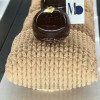 Masahiko Ozumi Paris in Osaka makes the comfiest desserts around
Masahiko Ozumi Paris in Osaka makes the comfiest desserts around Beautiful Sailor Moon manhole cover coasters being given out for free by Tokyo tourist center
Beautiful Sailor Moon manhole cover coasters being given out for free by Tokyo tourist center Disney princesses get official manga makeovers for Manga Princess Cafe opening in Tokyo
Disney princesses get official manga makeovers for Manga Princess Cafe opening in Tokyo Starbucks reopens at Shibuya Scramble Crossing with new look and design concept
Starbucks reopens at Shibuya Scramble Crossing with new look and design concept Beautiful new Final Fantasy T-shirt collection on the way from Uniqlo【Photos】
Beautiful new Final Fantasy T-shirt collection on the way from Uniqlo【Photos】 Is the new Shinkansen Train Desk ticket worth it?
Is the new Shinkansen Train Desk ticket worth it? Foreign English teachers in Japan pick their favorite Japanese-language phrases【Survey】
Foreign English teachers in Japan pick their favorite Japanese-language phrases【Survey】 Japanese convenience store packs a whole bento into an onigiri rice ball
Japanese convenience store packs a whole bento into an onigiri rice ball We try out “Chan Ramen”, an underground type of ramen popular in the ramen community
We try out “Chan Ramen”, an underground type of ramen popular in the ramen community Studio Ghibli releases Kiki’s Delivery Service chocolate cake pouches in Japan
Studio Ghibli releases Kiki’s Delivery Service chocolate cake pouches in Japan Japan’s bone-breaking and record-breaking roller coaster is permanently shutting down
Japan’s bone-breaking and record-breaking roller coaster is permanently shutting down New definition of “Japanese whiskey” goes into effect to prevent fakes from fooling overseas buyers
New definition of “Japanese whiskey” goes into effect to prevent fakes from fooling overseas buyers Our Japanese reporter visits Costco in the U.S., finds super American and very Japanese things
Our Japanese reporter visits Costco in the U.S., finds super American and very Japanese things Studio Ghibli unveils Mother’s Day gift set that captures the love in My Neighbour Totoro
Studio Ghibli unveils Mother’s Day gift set that captures the love in My Neighbour Totoro Foreign passenger shoves conductor on one of the last full runs for Japan’s Thunderbird train
Foreign passenger shoves conductor on one of the last full runs for Japan’s Thunderbird train Domino’s Japan now sells…pizza ears?
Domino’s Japan now sells…pizza ears? New Japanese KitKat flavour stars Sanrio characters, including Hello Kitty
New Japanese KitKat flavour stars Sanrio characters, including Hello Kitty Kyoto creates new for-tourist buses to address overtourism with higher prices, faster rides
Kyoto creates new for-tourist buses to address overtourism with higher prices, faster rides Sales of Japan’s most convenient train ticket/shopping payment cards suspended indefinitely
Sales of Japan’s most convenient train ticket/shopping payment cards suspended indefinitely Sold-out Studio Ghibli desktop humidifiers are back so Totoro can help you through the dry season
Sold-out Studio Ghibli desktop humidifiers are back so Totoro can help you through the dry season Japanese government to make first change to romanization spelling rules since the 1950s
Japanese government to make first change to romanization spelling rules since the 1950s Ghibli founders Toshio Suzuki and Hayao Miyazaki contribute to Japanese whisky Totoro label design
Ghibli founders Toshio Suzuki and Hayao Miyazaki contribute to Japanese whisky Totoro label design Doraemon found buried at sea as scene from 1993 anime becomes real life【Photos】
Doraemon found buried at sea as scene from 1993 anime becomes real life【Photos】 Tokyo’s most famous Starbucks is closed
Tokyo’s most famous Starbucks is closed One Piece characters’ nationalities revealed, but fans have mixed opinions
One Piece characters’ nationalities revealed, but fans have mixed opinions We asked a Uniqlo employee what four things we should buy and their suggestions didn’t disappoint
We asked a Uniqlo employee what four things we should buy and their suggestions didn’t disappoint Princesses, fruits, and blacksmiths: Study reveals the 30 most unusual family names in Japan
Princesses, fruits, and blacksmiths: Study reveals the 30 most unusual family names in Japan The bunnies! There’s… too many of them! AAARGH!!!
The bunnies! There’s… too many of them! AAARGH!!! Osaka to Fukuoka for less than 40 bucks? It’s possible with Japan’s overnight ferry
Osaka to Fukuoka for less than 40 bucks? It’s possible with Japan’s overnight ferry Starbucks Japan releases cute new zodiac goods for Year of the Rabbit
Starbucks Japan releases cute new zodiac goods for Year of the Rabbit Breathtakingly beautiful beach in often-overlooked part of Japan is like a scene out of Your Name
Breathtakingly beautiful beach in often-overlooked part of Japan is like a scene out of Your Name The fate of jack-o-lanterns in Japan: to be adorably devoured by a writhing mass of bunnies
The fate of jack-o-lanterns in Japan: to be adorably devoured by a writhing mass of bunnies Giant rabbit takes over Taiwanese military bunker
Giant rabbit takes over Taiwanese military bunker Big, drunk and furry—Everything you need to know about tanuki (plus a song about their balls!)
Big, drunk and furry—Everything you need to know about tanuki (plus a song about their balls!) You can find the happiest pigs in the world on “Pig Island”, and swim with them too!【Photos】
You can find the happiest pigs in the world on “Pig Island”, and swim with them too!【Photos】 Adorable bunny pouches from Japan look like real, live rabbits!
Adorable bunny pouches from Japan look like real, live rabbits! This private island in the Pacific Ocean is open to guests – but only Japanese ones
This private island in the Pacific Ocean is open to guests – but only Japanese ones Visit Kiki’s Bakery at a unique fairytale village in Japan
Visit Kiki’s Bakery at a unique fairytale village in Japan Poor bunnies! Chinese news program makes rabbits wear contact lenses to test what we already know
Poor bunnies! Chinese news program makes rabbits wear contact lenses to test what we already know W.T.F. Japan: Top 5 offbeat Japanese animal cafes【Weird Top Five】
W.T.F. Japan: Top 5 offbeat Japanese animal cafes【Weird Top Five】 Ed Sheeran invited to visit cat island in Japan with video from Japanese town
Ed Sheeran invited to visit cat island in Japan with video from Japanese town Japan has rabbits that cosplay each fall…as other rabbits?!? 【Photos】
Japan has rabbits that cosplay each fall…as other rabbits?!? 【Photos】 Don’t know which sake to drink? These handy flavor charts help you pick by region of Japan
Don’t know which sake to drink? These handy flavor charts help you pick by region of Japan
Leave a Reply